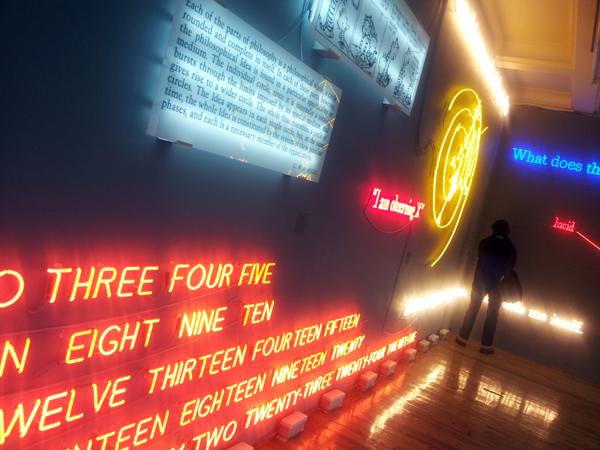Sprüth Magers, presents an exhibition of Joseph Kosuth ‘Amnesia: Various, Luminous, Fixed.’ featuring work that dates from 1965 up to 2011, the exhibition is said to offer an extensive overview of Joseph Kosuth’s oeuvre in neon. The show chronicles an almost 50-year investigation into the role of language and meaning in art, as well as Kosuth’s use of neon, which he first developed as a medium in the 1960s, a practice that is said to precede Bruce Nauman, Mario Merz and Keith Sonnier, when the artist considered the medium a form of ‘public writing’, without fine art associations.
The exhibition features 25 of the artist’s neon works, presented in installation format, including one of the artist’s first neons ‘Five Fives (to Donald Judd)’ [orange] (1965), alongside recent works such as three from his Beckett series (2011). ‘Amnesia: Various, Luminous, Fixed.’ follows ‘Insomnia: Assorted, Illuminated, Fixed.’, a previous exhibition of work by Kosuth at Sprüth Magers, Berlin in 2013.
Upon entering the gallery at Sprüth Magers, one is met with battleship grey walls, the artist’s condensed body of work is emitting a steady hum, and the air is stuffy with the heat of so many lights. There is a slight feel of the fairground to this installation, even though the use of neon in contemporary art is now such an every-day occurrence, that instead of surprise it is simply considered a standard sculptural language in its own right; the shear abundance of neon in the confined space gives the show a slight air of an amusement arcade.
Kosuth initiated appropriation strategies, language-based works and the use of photography as early as the 1960s. The artist’s practice develops his investigations into language and perception through the use of bodies of work, this particular format opens up space for play and reflexivity in multiple directions it is stated; this process of creating is similar to the construction of paragraphs in writing, tying works of actual language together in the construction of a pseudo ‘chapter’ of work, forming relationships between the works in a confined space, in an attempt to explore and create greater meaning.
The artist’s series are pure language apart from the incursion of a number of diagrams and a couple of philosophically inclined cartoons on back-lit Perspex, one of them from a Calvin and Hobbes comic strip. Kosuth’s art brings into question the relationship between art, philosophy, and language. The artist’s installation is an extreme abbreviation of Kosuth’s legacy of works, but the viewer can easily recognise the artist’s fascination with this subject matter.
‘Five Fives (to Donald Judd)’, from 1965, is the earliest work from the artist’s oeuvre to make up this installation and is five rows of five words, of the numbers one through to 25 which stack up along the wall of the gallery. Like the nearby phrase “An Object Self-Defined” from the work ‘Self-Defined Object [green]’, 1966, the artist forms the relationship between words and art object, short-circuiting its separation, language and art, language in art, language as, or is art, the work professes to form a dialectic that results in a relationship to philosophical thought.
In the artist’s Freud series (1981-1989), Kosuth re-asserts the relationship between the language of art and the written form; re-positioning the meanings employed in psychoanalyst’s texts with pieces and installations. ‘Fetishism (Corrected)’ (1988), for instance, consists of an enlarged reproduction from Freud, complete with corrections by Freud’s hand, of the opening page proof of the essay ‘Fetischismus’. Kosuth converts the corrections and turns them into cobalt blue neon, mounting the works together on the wall around the framed proof. The artist posits a theory visually: that writing can be studied and converted into artefacts, and from artefacts to art, whereas art can be converted. Both are pure languages for the purposes of communicating a philosophy, becoming one in the process.
To study the artist’s work is to attempt to explore a vast interconnecting landscape of intellectualisms, that often intentionally fold in on themselves; the interlacing complexities of art, language, and philosophy, often forming a cyclical equation of forms. But with the addition of the artist’s surreptitious wall texts the viewer has a serious conundrum.
Kosuth adds a quite comprehensive explanation of the exhibition throughout, with almost more text than there are words and symbols present in the actual works, attempting to re-affirm the reasoning and meaning behind his art, and by doing so creates an extraordinary contradiction to the very existence of his lengthy investigation into the relationships between language and art – by denying the work a voice of its own.
The real short-circuit is in creating a body of work that professes to successfully form a relationship to these complex subject matters – in a sense forming its own language – then writing an explanation which suggests that without this addition the viewer would be lost. The result is pure paradox.
‘Amnesia: Various, Luminous, Fixed’ – Sprüth Magers London – until February 14, 2015.
Words: Paul Black Photo: courtesy of P A Black © Artlyst 2015 all rights reserved

